Fear-mongering Versus Reality in New York Parole
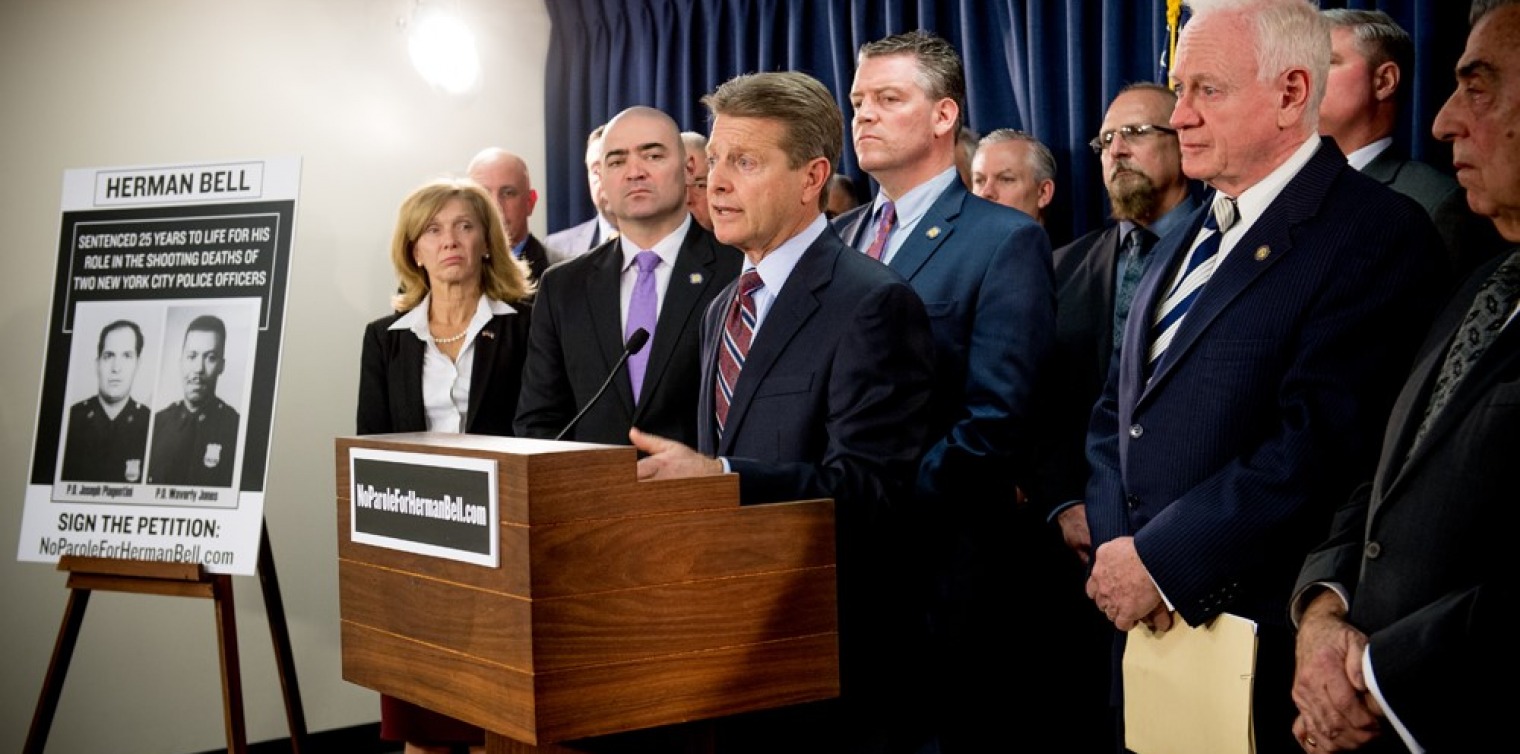
Senate Republicans oppose Herman Bell's parole (photo via Senator Patrick Gallivan's website)
Juxtaposed with the decision by New York State Senate Republicans to hold hearings to voice anger over decisions by the Parole Board was this past Friday’s annual Parole Summit of the Lifers and Longtermers Organization at Otisville Correctional Facility.
Summit attendees, including parole reform advocates, clergy, academics, and a judge from the New York Court of Appeals, heard person after person talk passionately about the Lifers’ commitment to their “Four Rs” of responsibility, remorse, reconciliation, and rehabilitation. By day’s end it was clear that for many people behind bars there is a fifth “R” – redemption.
The transparent political motivation to hold hearings so close in time to elections is made all the more shameful by the appeal to fear-mongering, as comments already circulating by Senate Republicans raise the specter of droves of dangerous criminals randomly turned loose on the streets of Albany and Long Island, the chosen sites for the hearings, and elsewhere.
Senator Patrick Gallivan, Chair of the Crime Victims, Crime and Correction Committee that co-sponsored the hearings, characterizes a select few Board decisions granting parole as “indefensible and an affront to law-abiding citizens.” To the contrary, the Board followed the laws and regulations that govern the Board’s decision-making. Far more troubling to law-abiding citizens is an elected official urging the Board to flout the law.
The Legislature passes laws that set minimum and maximum sentences, and judges mete out sentences pursuant to those laws. A person becomes eligible for parole after they have served their minimum judicially-imposed sentence. The Legislature has enumerated a number of factors that the Parole Board must consider when weighing whether to grant parole. If you have done well while incarcerated -- completed all required programs, avoided serious disciplinary infractions, accepted responsibility for your actions, and made a thorough re-entry plan -- you should be released. That is the law. Indeed, that is what people are told when they are sentenced.
Long-overdue changes to the laws and regulations that govern parole direct the Board to take a forward-looking approach; evaluate who the person is today instead of fixating on the crime of conviction from often decades earlier. Now, the Board is required to utilize an objective evidence-based risk-assessment tool to determine whether someone presents a risk of future violent behavior. Elected officials who suggest that the Parole Board is turning loose a slew of dangerous criminals conveniently ignore that each of these people were deemed to be at the lowest possible risk for re-offending. They also elide the fact that each of these people served decades in prison before they were released. Not only have they been significantly punished, but, according to every study of age and crime, they have long ago “aged out” of any real possibility of future criminal conduct. Put simply, they are profoundly different people at age 50, 60 or 70 than they were when they were in their teens or twenties.
Several Senators also refer disingenuously to the Board’s “seeming automatic releases.” That is patently untrue. The most controversial cases of the past year all involve people who had been denied parole eight, nine, ten, or more times spanning decades. However, consider the recent case of Richard DiGuglielmo. Mr. DiGuglielmo was convicted of murder and sentenced to 20 years to life in a high-profile case involving the killing of a black man by a white off-duty police officer in a dispute over a parking space. Mr. DiGuglielmo served his 20-year minimum and was released at his very first appearance before the Board, a very rare outcome for someone convicted of murder, especially considering the objections from the victim’s family. Notably, there was no outcry from the Republicans members of the Crime Victims, Crime and Correction Committee.
The Board is subjected to relatively little public opprobrium when it chooses to deny parole. Contrary to the claims of Senate Republicans, the far larger problem with the Board, as made abundantly clear at the Otisville Parole Summit, is its habit of routinely denying parole to the many people who have so fully transformed, decisions based solely on the serious nature of the crime of conviction, something the person can never change. These punitive, backward-looking decisions ignore the innate human capacity to change and are ultimately cold and merciless.
The epidemic of mass incarceration is now readily acknowledged. The 130 Lifers and Longtermers at the Otisville Summit have collectively served more than 2,400 years in prison. Many of them have been denied parole repeatedly based exclusively on the crime of conviction from decades before. Contrary to the views of Republican members of the Crime Victims, Crime and Correction Committee, decisions grounded in the extant laws and regulations to grant parole should be praised, not pilloried, and must not be influenced, let alone determined, by who yells the loudest.
***
Steven Zeidman is a professor of law at CUNY School of Law. On Twitter @SteveZeidman.
***
Have an op-ed idea or submission for Gotham Gazette? Email This email address is being protected from spambots. You need JavaScript enabled to view it.
Closing the Door on Foreign Money in New York City Elections
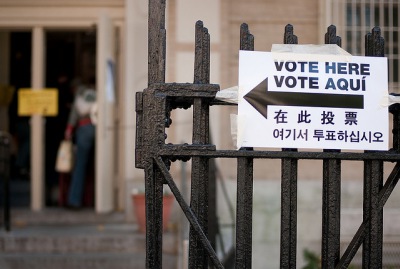
How far and how deep did the Russian government and Russian nationals go to influence United States elections? While hacking and manipulation of social media have garnered significant attention from both the media and the Mueller investigation, it’s also clear that Russian money was being funneled through some surprising channels, such as the National Rifle Association (NRA).
When Citizens United opened the floodgates for corporations to spend unlimited amounts in our elections, it also blasted open a loophole for foreign money to be used to influence U.S. elections. Earlier this month, we collaborated to introduce a bill to close that loophole and keep foreign money out of New York City elections.
While current federal law—affirmed by the Supreme Court in 2012—prohibits foreign governments, foreign-based companies, and people who are not U.S. citizens or permanent residents from contributing or spending money in connection with any federal, state, or local elections, after Citizens United, foreign entities can still invest money through U.S.-based corporations that can then spend as much money as they want on American elections. That’s a direct threat to democracy, and one that our federal government has yet to remedy.
This is not a hypothetical. Companies that we consider to be “American” often have significant foreign investment, and at times that investment comes from some questionable sources. DST Global, for example, has gained notoriety for its Russian connections and has significant investment in many U.S. tech companies, including several iconic companies like Airbnb, Facebook, and Twitter. Saudi Arabia has also been “using its wealth for global influence” with over $2 trillion to invest via its sovereign wealth fund, and it has already taken large stakes in U.S. based companies like Uber, Tesla, and Sprint through its joint tech fund with SoftBank Group, a Japanese company. To be clear, we do not mean to say that these companies are controlled by Russia or Saudi Arabia, but they do serve as examples of how little we know about the foreign ownership of American companies, some of which spend significant amounts trying to influence American politics.
As the U.S. midterm elections approach, foreign actors are testing out new ways to hide their trails. They’ve stopped paying in rubles, and that means that the corporate loophole created by Citizens United will be ever more attractive. The evidence is also mounting that Russia was not alone. Saudi Arabia, the United Arab Emirates, Qatar, and others reportedly sought to put their thumbs on the scale. Though Ellen Weintraub, the vice chair of the Federal Election Commission, has been sounding the alarm about this for years, partisan politics has stopped attempts in Congress and at the Commission to prevent foreign money from being funneled through corporations.
That’s why it is critical to move now to protect our local elections from corrupt foreign influence and to help create a national model for campaign finance reform. In order to protect the integrity of New York City elections, our bill -- Intro. 7087 -- would strengthen the existing federal prohibition on direct foreign and corporate campaign contributions by extending the ban to American corporations under substantial foreign ownership or control.
The bill would prohibit contributions and spending in local elections by “foreign-influenced entities,” which is defined as an entity that is either (1) more than 5 percent owned by a single foreign national, (2) more than 20 percent owned by more than one foreign national, or (3) a corporation in which foreign-national owners call the shots on its political activities. A similar proposal enacted in St. Petersburg, Florida received the backing of constitutional luminaries like Laurence Tribe and Charles Fried, and stands on firm legal ground.
New York has long been a leader in taking action to protect the integrity of its elections and ensure that the voices of New Yorkers are not drowned out by corporate money. New Yorkers deserve to know that foreign money is not flowing into local elections through hard-to-trace corporate channels. This bill upholds the basic principles of American self-government, free from foreign influence. Foreign interference is a clear and present danger, but by closing this gaping loophole New Yorkers can stem the flow of foreign money in their own elections and lead the way for the rest of the nation.
***
Public Advocate Letitia James
John Bonifaz, President, Free Speech For People
Shanna Cleveland, Senior Counsel, Free Speech For People
***
Have an op-ed idea or submission for Gotham Gazette? Email This email address is being protected from spambots. You need JavaScript enabled to view it.
Politics Created NYCHA; Only Politics Will Save It
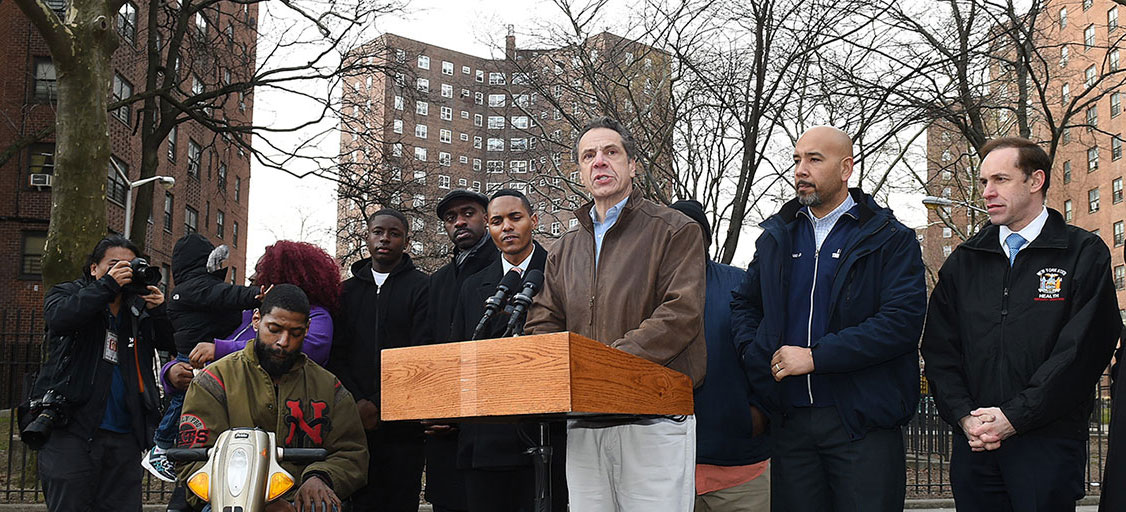
(photo via the Governor's office)
The New York City Housing Authority’s first developments in the 1930s rose from the frustrations of a massive working class tired of sweating and suffering in crappy tenements. NYCHA grew in the decades that followed, to about 175,000 apartments, thanks to consistent support from politicians under tremendous pressure from everyday New Yorkers, housing advocates, and the media.
Politics saved NYCHA multiple times from the fate of public housing in other American cities. The civil rights movement forced NYCHA to desegregate its projects after the 1930s. Outrage over management in the late 1950s led to a sacking of callous leadership handpicked by Robert Moses. New York’s Congressional delegation convinced their colleagues in both the 1970s and 1990s to assume responsibility for tens of thousands of city and state public housing projects.
NYCHA residents, New York politicians, and many advocates, however, failed to adjust fast enough to a new national political reality. The rest of America, including most federal officials overseeing the program, viewed public housing as a dead program by the 1990s -- and treated it as such. Federal officials have since then intentionally refused to fund NYCHA’s capital or operating needs at a level sufficient to maintain the quality of life to which residents had become accustomed.
Frustrated residents for years disconnected from the political process despite the growing threat of aging apartments and buildings. Other affordable housing preservation and development programs took priority for many housing advocates and elected officials. City, federal, and state politicians pointed fingers at each other. The results of disinvestment are on display despite NYCHA apartments remaining full and much desired in New York.
In just a few years of crisis, however, it already seems the wheel is turning. Residents and housing advocates have kept the heat on politicians, feeding a steady stream of heartbreaking images and stories to the media and the courts. Elected officials can’t pick up the paper or turn on the TV without reading about a problem, often in their district. Crisis on an unprecedented scale has forced the issue to the front time and again: Sandy flooding, deep freeze, mold, lead.
Has the result of all this bad press been the abandonment of public housing as in other cities? No. Where bad press led to demolition in other cities, in New York negative attention seems to be leading to a steady and growing flow of money to renovate public housing. Demolition could still happen in New York but knocking down NYCHA is still a third rail of politics here -- and unimaginably complex to boot. We simply don’t have additional homes, short- or long-term, for more than 400,000 poor people.
Already, the totals won for NYCHA are mounting: $3 billion for Sandy reconstruction from FEMA; billions from the city so far and billions more promised (thanks to a consent decree) for roofs, boilers, lead tests, and more; hundreds of millions promised from the state. NYCHA has also quietly done what it can with remaining federal capital funds since the 1990s to stabilize conditions, working from the outside in on building envelope bricks and roofs. NYCHA successfully used the federal RAD program to upgrade housing for thousands of residents now living under private sector management—and plans for thousands of additional apartments in this program are underway.
Renovation of such a big system moves much more slowly than residents want and often fails to address immediate needs in their apartments -- but it is happening. That refitting of public housing is happening at all, rather than demolition, speaks to tenant activism of NYCHA residents and their advocates. When a crisis hit public housing elsewhere, politicians have used a crisis to demolish, not rebuild housing (New Orleans after Katrina, for instance, demolished vast projects).
New York’s public housing movement, however, needs to be creative and flexible in the next steps. Residents and their allies should use their political power to pressure politicians to reform labor unions at NYCHA so tenants get economical and high-quality service. Residents and advocates have given the unions a free pass, but this is a strategic mistake because, without a revolution in the hours, roles, and compensation of NYCHA maintenance and custodial staff (comprising 40 percent of NYCHA’s annual budget), NYCHA residents are not going to enjoy major improvements in their quality of life.
Residents and advocates also need to force the Mayor to come up with a reasonable long-term plan for investment. While an immediate commitment of the estimated $31 billion needed for top-to-bottom renovation is unrealistic, even a lot less can upgrade the quality of life. The city, for instance, needs to integrate NYCHA into its annual capital planning process. Given the growing importance of NYCHA to reducing homelessness, and of infill sites to the city’s affordable housing plans, it only makes sense that NYCHA gets a larger share of city support. Residents should also light a fire under Democratic majorities in Albany and the Governor to find money for additional renovation and public-private partnerships.
NYCHA remains a crucial service for many New Yorkers and one that helps preserve diverse neighborhoods in the face of gentrification. And just because a housing system delivers a product that many people wouldn’t choose for themselves doesn’t mean it isn’t valuable to lots of other people with fewer choices or different values. Mass services like public housing, public transit, and public education will always “lose” money because the people who need and use them generally lack the money to pay the real cost of running a complex urban service whether it be for a subsidized apartment, a subway ride, or a public classroom. It is, however, up to the recipients of these systems to use the political system to secure and protect these essential services.
***
Nicholas Dagen Bloom is a professor at New York Institute of Technology and author of many books.
***
Have an op-ed idea or submission for Gotham Gazette? Email This email address is being protected from spambots. You need JavaScript enabled to view it.
Can Democrats win the state Senate? How progressive is Cuomo? New Yorkers are about to find out
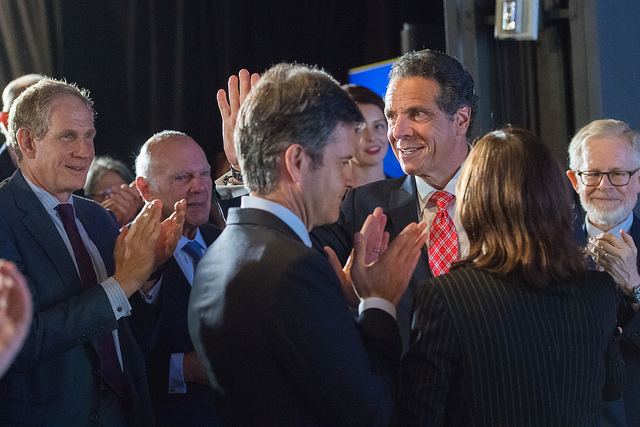
Gov. Cuomo (photo via the Governor's office)
In the November 6 general election, New York Democrats have a historic opportunity to take control of the state Senate. If this happens, Democrats would control both houses of the state Legislature for only the third time in the last 100 years, unlocking years of bottled up progressive legislation passed by the Democratically-controlled Assembly but blocked by the Republican-controlled Senate.
Assuming Governor Andrew Cuomo, a Democrat, wins reelection as he is expected to, a number of these bills may very well land on his desk, including those related to universal health care; election, voting and campaign finance reforms; reproductive health rights; equal education funding for city schools; equal protections for LGBT and disabled people; carbon emissions elimination; immigration protections, including making New York a sanctuary state; and criminal justice reforms.
Recent history should temper optimism, however. New York Democratic voters chose the status quo over the bold reforms represented by the Cynthia Nixon-Jumaane Williams-Zephyr Teachout ticket in September’s primaries and in last year’s constitutional convention ballot referendum. In the 2016 state Senate races, 98% of incumbents were re-elected, though one good sign for Democrats in their quest to take over the chamber is the handful of retirements in the GOP conference.
We’ll soon see how powerful New York’s blue wave really is, both on Election Day and in the legislative session that will follow beginning in January. A few key questions:
But didn’t progressives just defeat the IDC?
Sort of and it’s insufficient.
Before the primary, there were actually more “Democrats” in the state Senate than Republicans, even though the GOP conference held a 40-23, then 32-31 majority in the 63-seat chamber.
Nine Democrats were either part of the Republican conference or in a power-sharing agreement via the Independent Democratic Conference (IDC), giving the GOP a majority for the recent two-year legislative session (and prior) and preventing progressive legislation from reaching the Senate floor. Eight of those senators were members of the IDC, which did rejoin the “mainline” Democratic conference in April, after a new state budget had been passed, which led to the 32-31 GOP majority for the final months of the session that ended in June.
In the September 13 primary, six former IDC members were defeated. The ninth rogue Democrat, Senator Simcha Felder of Brooklyn, has been part of the Republican Conference for multiple terms, and was even reelected in 2016 on both the Democratic and Republican ballot lines. He won his primary challenge last month.
Despite losing in the Democratic primary, all six defeated former IDC members are likely to remain on November’s ballot on other party lines, often the Independence Party and/or Women’s Equality Party. There’s no guarantee they won’t actively campaign if for no other reason than as spoilers, though most appear unlikely to do so. Democratic leaders may try to reward defeated IDC members -- like former conference leader Senator Jeff Klein and Senator Jesse Hamilton -- with judgeships to keep them from actively campaigning. Klein, along with Senators Jesse Hamilton and Tony Avella, is one of three former IDC members who were defeated in the primary and have not yet declared that they won’t campaign in the general.
Surviving former IDC Senators David Carlucci and Diane Savino, along with Felder, will almost certainly win re-election in November.
What do Democrats really need to do?
Net one seat. If Democrats flip just one GOP-held Senate seat and hold onto those they currently have, then Democrats will have a real 32-31 majority heading into next year. Competitive Senate races exist on Long Island and upstate, including several districts where Democrats failed to run any candidate at all in 2016. There’s also a seat in Southern Brooklyn that represents why many GOP-held districts are vulnerable.
Since 2012, when incumbent Republican Senator Marty Golden won his last competitive race, the district’s demographics have changed dramatically. Today, 40% of residents are now people of color, especially Asian and Hispanic; and 43% are immigrants, primarily Asian, eastern European and Mexican. Residents work in blue collar industries like transportation, wholesale, and construction. Virtually every racial group earns less than the median for New York State. These changes create the setting for the red-to-blue opportunity for progressive Democrat Andrew Gounardes, Golden’s opponent in 2012.
What’s possible?
Flipping nine seats. My most optimistic scenario has Democrats flipping nine GOP-held seats for a 40-23 majority.
If the primaries were any indicator, November turnout will be high, which will benefit Democrats due to their two-to-one registration advantage across the state. Primary turnout more than doubled since the last comparable election in 2014. In Long Island’s Nassau and Suffolk counties, Democratic primary turnout actually tripled from 2014 to this year.
Democrats are mounting competitive races in the five GOP-held districts where the current officeholder is retiring. In 2012, Obama carried all of those districts; In 2016, Clinton carried one and Trump won by 6% or less in the other four. Democrats are also contesting several other races where the Republican officeholder is seen as beatable.
Here is my list for the best opportunities for Democrats to flip GOP-held Senate seats. In compiling this list, I considered voting results by state Senate in the two most recent presidential elections, fundraising, the power of incumbency and signals of grassroots support.

Past voter preferences matter. The 2012 presidential election was more reflective of deeply felt beliefs in these districts, which had with one exception solid pluralities for Obama. Democratic voters who stayed home may have contributed to the mixed results of the 2016 election. By this year, 2016’s GOP victories didn’t deter -- and perhaps motivated -- Democratic contributors and may have awakened Democrats who came out in droves to vote in this year’s primary. In addition, changing demographics have also affected these districts in ways that potentially favor progressive Democratic candidates.
Money matters -- to pay for campaign staff, advertising, get-out-the-vote efforts, and more. The table above includes the most recent Board of Elections campaign disclosures, filed by September 24, and showing money in the bank as of the filing. Some candidates benefited from the lack of a primary, which means they have more funds for the general election, but may not have benefited from public exposure without opposition.
The New York Daily News reports that Cuomo intends to fund-raise for several Senate candidates, including Gounardes, D’Amaro, Kaplan, Skoufis, Smythe, and Metzger. The two other Democratic candidates mentioned in the Daily News story -- Monica Martinez in SD-3 and Pete Harckham in SD-40 -- don’t appear to be currently competitive based on funds raised and the lack of time before Election Day.
Aren’t there Democrats at risk?
Incumbent Democrats largely appear safe. John Brooks in Senate District 8 on Long Island is often mentioned as a potential risk, probably due to his narrow 214-vote (0.2%) win in 2016 over then-incumbent GOP Senator Michael Venditto. But now-incumbent Brooks has a solid fundraising lead over the current GOP candidate, Jeff Pravato, in a district that went for Hillary Clinton and Obama and has a solid Democratic voter registration advantage.
Democrats need to ensure that primary victors Rachel May in SD-53 and Alessandra Biaggi in SD-34, both of whom beat IDC members, continue their momentum through November. The IDC incumbents they defeated are likely to appear on other ballot lines and have significant money. May’s opponent, David Valesky, reported $340,038 post-primary to May’s $41,209, though he has recently declared that he will not campaign in the general.
Biaggi’s opponent, former IDC leader Klein, reported $957,827 just before the primary to Biaggi’s post-primary balance of $172,909. As of this writing, Klein’s post-primary filing still hadn’t been published and he had not indicated his general election plans.
So what’s going to happen?
On November 6, Democrats will take control of the New York State Senate with a solid majority that Republicans cannot hold back. This, along with holding onto a wide majority in the Assembly, will likely result in a steady stream of progressive legislation on the governor’s desk to sign, giving Cuomo the opportunity to make history New York has been waiting for.
***
Art Chang is a writer, thinker and strategist at the intersection of technology and government. He is a former board member of New York City’s Campaign Finance Board, where he led the creation of NYC Votes and Voting.NYC. On Twitter @achangnyc.
***
Have an op-ed idea or submission for Gotham Gazette? Email This email address is being protected from spambots. You need JavaScript enabled to view it.
Doing the Mass Bail Out the Right Way
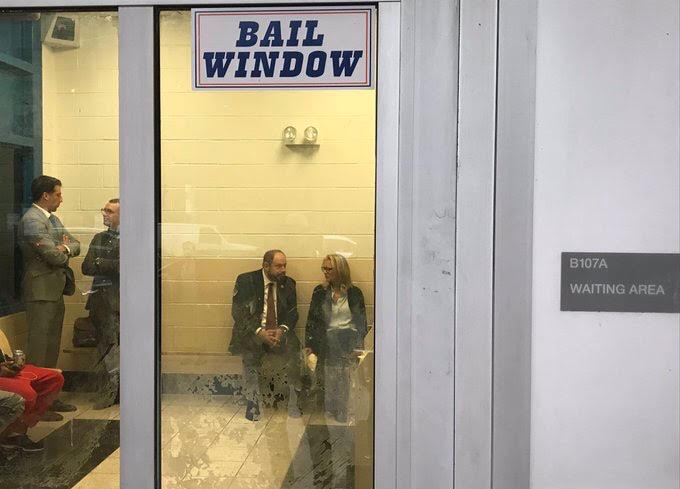
(photo via @RoryLancman)
The Robert F. Kennedy Human Rights Foundation’s just-launched “mass bail out” -- which could release from New York City jails 500 incarcerated indigent young and women defendants charged with misdemeanors and violent felonies -- is a good plan if it is implemented responsibly.
The plan dramatically highlights the bail system’s glaring inequities, as thousands sit in jail for months, unable to pay bail.
Not surprisingly, the plan has caused an immediate and strong reaction, particularly from the NYPD.
NYPD Commissioner James O’Neill warned of an oncoming crime wave if the Foundation’s bailed defendants are released, claiming it will make New York City “less safe.” He also decried, “What about the victims? What about witness intimidation? What about retaliation?” New York City’s district attorneys have sided with O’Neill; though oddly, they remain some of the biggest supporters of bail reform.
The fear is that newly bailed defendants will start a crime wave even though no crime wave was ever started by those with the financial resources to make bail. In fact, most defendants on bail return for their court date.
This unfounded fear only underscores the economic disparity in our court system and is inconsistent with justice and with New York state law.
Bail is set at arraignment: the prosecutor and defense attorney are heard, then a judge applies the statutory criteria for setting bail, including considering the main standard: will a defendant return to court for his or her case.
Perhaps defensively, the Foundation’s president mistakenly stated, “If a judge feels this person is a danger to society, they will not make them bail eligible.” New York does not have a pre-trial detention bail criteria. However, federal law specifically permits pre-trial detention if “such person poses a danger to any other person or the community.”
It also demonstrates just how tricky ending bail inequity is.
But, before the Foundation and its partners can implement their program they must have a dialogue with the city’s district attorneys regarding their bail policies and concerns.
Before posting bail the advocates must consider why bail was set by a judge and ensure a potentially released defendant meets any conditions, such as not contacting a victim or witness and attending future court appearances. After all, this plan places the Foundation in the place of a family member who would normally put up bail and suffers a financial hardship if a defendant skips court. This means the Foundation will also have to supervise the defendant while on bail.
The Foundation and partners must also comply with existing bail laws, which restrict depositing bail for multiple defendants. Among other things, New York State’s Superintendent of Insurance must authorize a certificate for the Foundation to become a “charitable bail organization.”
Other opportunities for bail reform dialogue also exist.
For instance, a reform must include fast tracking incarcerated young defendants’ cases to disposition.
Encouraging the NYPD to issue Desk Appearance Tickets (DATs) for all misdemeanor arrests and seeking statutory authority to issue DATs for nonviolent low-level felony arrests. A DAT releases an accused with a future court date at the station house without waiting 18-24 hours in custody for arraignment.
There must be greater use of existing non-cash bail alternatives permitted under New York law, eliminating costly bail bonds.
The Foundation’s program – if successful – is a significant step forward for criminal justice and bail reform. After more than 20 years of stop-and-frisk excesses, broken windows arrests, and inequitable bail practices, economic disparity must end for the many who are incarcerated in our city’s jails waiting inordinately for their day in court.
***
Arnold N. Kriss is an attorney in private practice in Manhattan, and a former NYPD Deputy Commissioner for Trials and Brooklyn Assistant District Attorney. On Twitter @ArnieKriss.
***
Have an op-ed idea or submission for Gotham Gazette? Email This email address is being protected from spambots. You need JavaScript enabled to view it.
Show the Lefkowitz Some Love
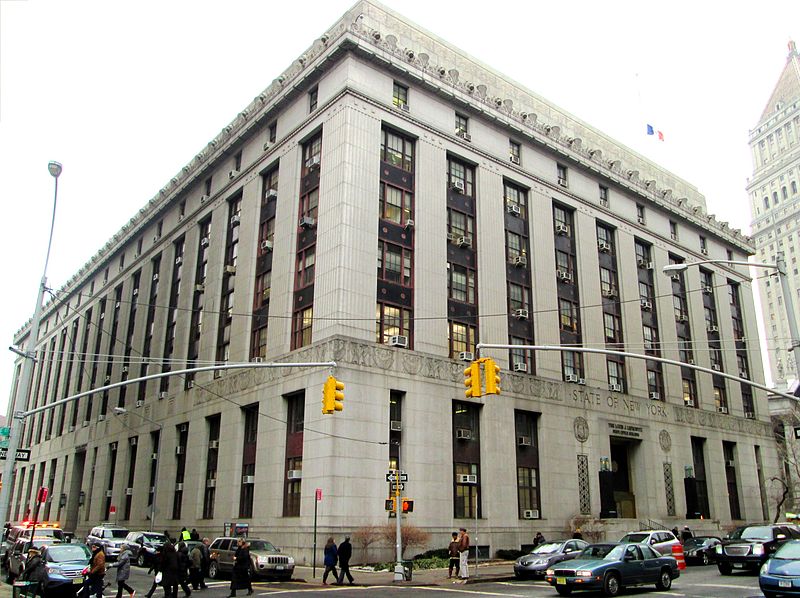
The Lefkowitz Building (photo: Beyond My Ken via Wikimedia Commons)
For nearly a decade, lovers have flocked to Lower Manhattan’s magnificent Louis Lefkowitz Building.
Why, you ask?
The handsome Lefkowitz is home to the Manhattan Marriage Bureau. Each year, thousands of couples climb its distinctive stone stairs, pass under its carved eagle friezes, and enter its ornate inner lobbies to make their affection official.
The Lefkowitz is especially beloved by LGBT New Yorkers. A whopping 293 newly-eligible pairs wed there on the first day same-sex marriage became legal.
“Getting married in a place with such historical significance made me feel like I was a part of something,” explained Sarah Factor, who tied the knot at the Lefkowitz with her wife Julie Mayrin shortly after marriage equality passed in New York.
“When we were finally able to marry, we came to the Lefkowitz,” added Mayrin, matter-of-factly. “Going up those stairs was symbolic for me as a native New Yorker.”
But the Lefkowitz now needs a little love of its own.
Though marriage is supposed to be forever, Mayor de Blasio wants to give this temple of love an ugly divorce. De Blasio plans to gut – or even demolish – the beloved Lefkowitz to build a more humane jail for those facing trial in Manhattan.
As Mayrin sees it, the mayor’s plan would “destroy a monument.” And neighbors, elected officials, and concerned New Yorkers are beginning to agree.
Mass incarceration is among our society’s greatest sins, and de Blasio is correct to upend an intolerable status quo. With its large floor plates, outdated upper offices, and proximity to the criminal courts, it would be smart and simple to reuse certain parts of the Lefkowitz for pre-trial detention.
The Mayor can do all of this without evicting soon-to-be newlyweds and destroying a deeply admired New York structure. All it takes are a few vows from city officials.
First, the Landmarks Preservation Commission should protect the Lefkowitz’s façades, roofline, and first-floor public interiors. The City Council should then step up to the altar and pass legislation ensuring marriages remain in their rightful place for good.
None of this will happen without your help. Call, write, or visit the mayor, Landmarks Commission, and City Council – and demand they protect the Lefkowitz “till death do us part.”
***
Adrian Untermyer is an urbanist who advocates for historic preservation and improved transportation in Greater New York and nationwide. On Twitter @Untermyer.
***
Have an op-ed idea or submission for Gotham Gazette? Email This email address is being protected from spambots. You need JavaScript enabled to view it.
Race-Baiting Politics Has No Place in Our District, or Any
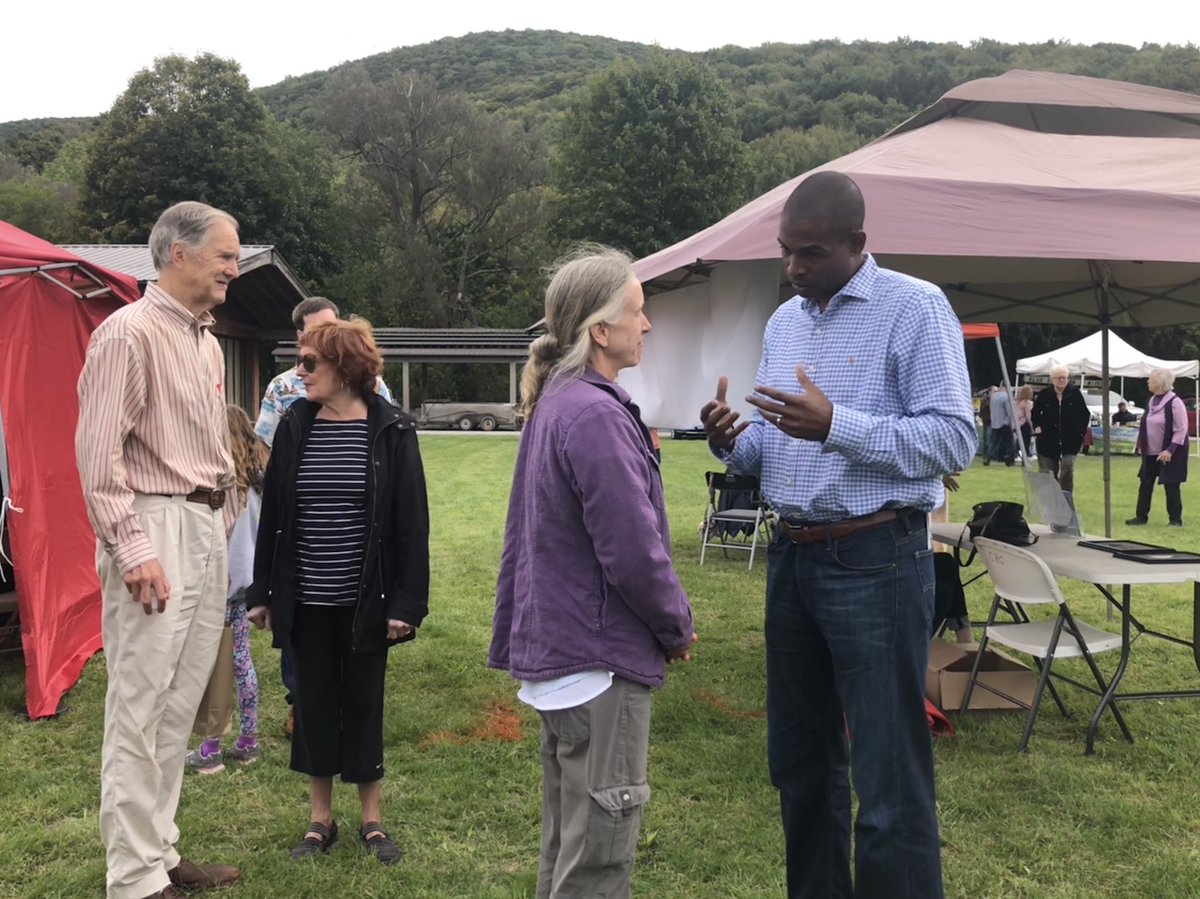
(photo: DelgadoforNY19)
Drive through Greene County New York, just 90 minutes north of New York City, and you’ll see a large sign on the highway that pretty concisely states the main takeaway of the campaign Republicans are running here in New York’s 19th Congressional District: “DELGADO FOR CONGRESS. NEVER. EX-RAPPER HATES WHITES & AMERICA.”
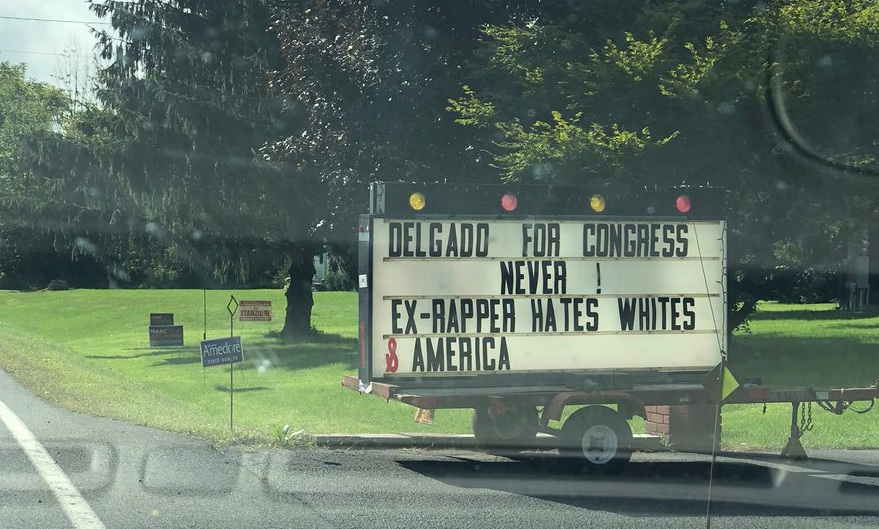
The sign’s recent appearance coincided with the release of a new television ad by the National Republican Congressional Committee (NRCC), where the narrator states that Antonio Delgado, the Democratic nominee for Congress, who is African American, “claims he’s like us,” before playing 30 seconds of cherry-picked and spliced hip-hop lyrics over noticeably darkened, hooded images of Delgado, taken from a short music career he pursued over a decade ago. As anyone living here in NY-19 will tell you, this ad, and many just like it, have been playing non-stop on television, radio, and sites such as Hulu and YouTube since early July, backed by nearly $2 million in spending from the NRCC and Speaker Paul Ryan's Congressional Leadership Fund Super PAC (CLF).
This isn’t the first time in history stoking racial prejudices has been deployed as an electoral strategy. But with a record number of Democratic House candidates who are people of color, the Republican party in 2018 appears to be abandoning its decades pattern of innuendo and coded language, and shamelessly taking these tactics to a new level – overtly race-based attacks against the candidates themselves.
Antonio Delgado is a formidable opponent. And I should know, he beat me in the Democratic primary campaign just a few months ago. He is an inspiring campaigner and tireless worker who grew up in Upstate New York to parents working middle class jobs at GE. He’s a Rhodes Scholar and a graduate of Harvard Law School — the type of story we don’t see enough of here in Upstate New York — a committed husband and father. And he has the kind of diversity of experiences Congress is so badly lacking, from his career in hip hop advocating for social justice, to his time as an attorney spending thousands of hours championing pro bono causes including fighting for reduced sentences for juveniles facing life imprisonment.
While politics is certainly not for the faint of heart, and both parties are guilty of running ads based on identity politics, this advertising campaign to appeal to the least common denominator crosses a line.
The barely veiled implication of the language that Delgado isn't “like us,” serves a simple purpose: to stir up fear in Upstate New York that a man born and raised in this community couldn’t possibly share our values simply because he is black and once was a music artist. It’s hard to see the feigned shock over Delgado’s lyrics as anything more than what it clearly is — race-baiting, and relying on the color of a candidate’s skin, rather than any policy or political differences, to convince the voting public (approximately 85% of which is white in NY-19) that Delgado is not deserving of support.
In response, the NY-19 community has united to denounce these attacks. Nearly 20 local clergy signed a letter to Rep. John Faso, the incumbent Republican representative, calling the ads “a thinly veiled, racist attack for the purpose of insinuating fear in the voters in our district.” A local radio station, WDST, announced it would stop running the ads — the first time the station has ever pulled a political ad off air — with the station’s president calling the ads “highly offensive and factually distorted.” This past week, our former Republican Rep. Chris Gibson denounced the ads, telling WAMC he "regrets" them. SUNY New Paltz Professor Dr. Gerald Benjamin, a friend of Faso, issued a public apology for his comments in a July New York Times story, admitting“the casual use of the phrase ‘people like us,’” has “racist connotations.” But the NRCC’s most recent advertisement uses that exact language — questioning whether Mr. Delgado is ‘like us.’
Unfortunately, this is not the first time Rep. Faso has resorted to such tactics. He has been running ads warning residents to the dangers of MS-13, using the same image of Hispanic men in tank tops and tattoos that was featured in Virginia gubernatorial candidate Ed Gillespie’s controversial “Kill. Rape. Control.” advertisement. He used the debate over the agriculture bill to champion ineffective “work requirements” for SNAP benefits by saying local sheriffs “tell me every drug dealer they arrest has a SNAP card in his pocket.”
Certain Republicans claim that President Trump’s racist statements and policies represent a different brand of politics than their own. Faso dubiously claims he has ‘no control’ over the advertisements.. His recent claim that "there's nothing racial about [the ad]” is either an outright lie, or reveals an astonishing lack of judgment from a sitting member of Congress about the obvious implications of this line of attack. However, unless Faso and Republican leaders openly disavow each of these ads, and Republican donors refuse to fund the NRCC and CLF as long as they run, they are wholly responsible.
The good news is, from my experience in this community, I know these tactics won’t win out. During my primary campaign, I traveled to all 163 towns in this congressional district and the people I met, though we had plenty of disagreements, are certainly not the kind of people who will be easily fooled by such divisive tactics. To younger voters such as myself, hip-hop music is not something scary or threatening, it’s now the most popular genre amongst music fans (Kendrick Lamar just won a Pulitzer).
People are showing up in record numbers to protest what’s coming out of Washington, to volunteer for campaigns, and to vote in primaries. In our congressional district alone, turnout doubled for the June primary and hundreds are volunteering every weekend. Republicans are scared, and they should be. But, while there are many permissible tactics in politics — some savory, some not — to draw contrasts between candidates, we as a nation, state, district, community, no matter which party we are in, are better than relying on stirring up racial prejudice to win elections. And I’m confident voters in the 19th congressional district and across the country will agree this November.
***
Gareth Rhodes ran in this year’s Democratic primary for Congress in NY-19 and is the executive director of Show Up 2018. On Twitter @garethtrhodes.
***
Have an op-ed idea or submission for Gotham Gazette? Email This email address is being protected from spambots. You need JavaScript enabled to view it.
Advancing an Inclusive Approach to School Meals
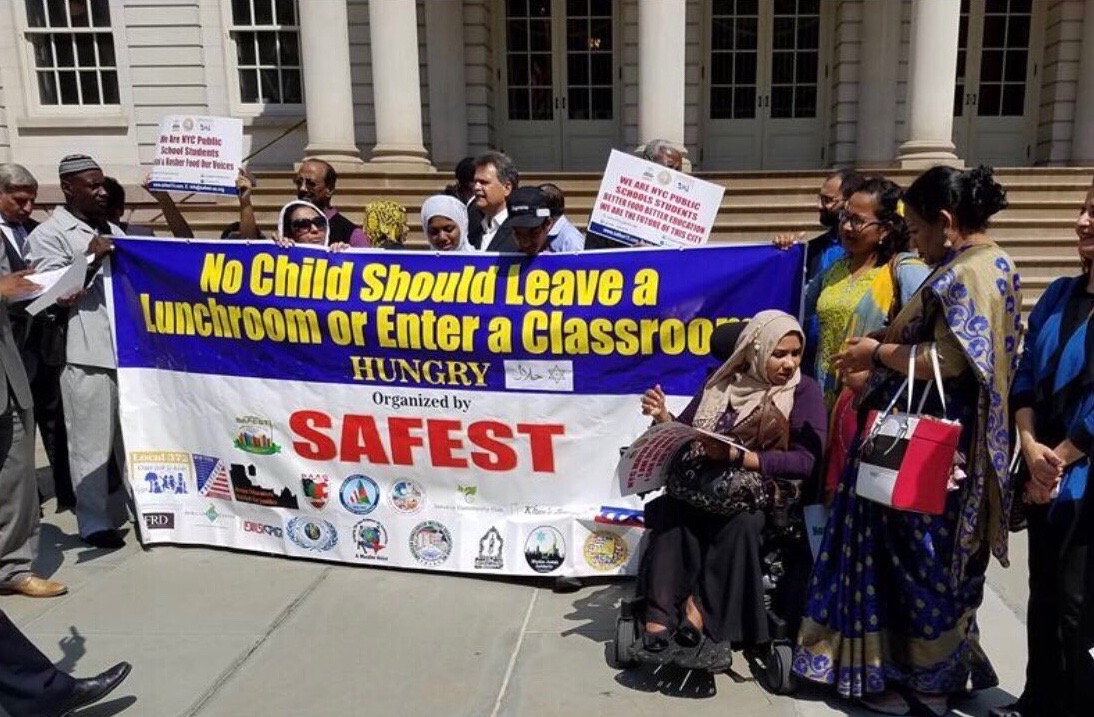
School food inclusivity rally (@safest)
We as faith leaders are most privileged to cooperate on a project that will benefit our respective communities. For far too long, students who follow religious dietary guidelines have found their public school cafeteria lacks sufficient accommodation in the food offered. Typically students who require a kosher or halal meal have very limited options in school lunch offerings, often choosing to eat nothing. At this time in history, with persistent and growing incidents of discrimination based on religious and racial animus, New York City needs to embrace every possible opportunity to show compassion, inclusivity, and accommodation for all students – and to ensure no child needs to leave the school cafeteria hungry.
It is impossible to know for sure how many students follow religious dietary restrictions. However, with roughly 38 percent of public school students identifying as Muslim or Jewish, it is possible that thousands of students do not participate in current Department of Education School Food programs because of their religious customs. And with 72 percent of the city’s public school students qualifying for free or reduced-price lunches – a potential indicator of food insecurity – it is clear that the number of students who could benefit from a halal or kosher meal in school is significant.
Many of us in the Muslim and Jewish faith communities, joined by community groups, have been advocating for years for the Department of Education to offer halal and kosher food options in schools. We know accommodating this request is not easy, given the complexities of a food distribution network that serves meals to approximately 600,000 students each day, second only to the U.S. Military.
Now, after years of advocacy, we are celebrating a key milestone: this year, $1 million has been allocated in the city budget to pilot halal and kosher school lunches in four schools. Thanks to the leadership of City Council Members Chaim Deutsch and Rafael Espinal and Speaker Corey Johnson, this historic funding will provide a solid foundation to pilot halal and kosher food options in city schools.
But funding the pilot is just the beginning. Our campaign is now facing a critical moment to ensure that the city designs and executes a halal and kosher pilot program responsibly, with full inclusion of parents and school communities who will benefit from halal and kosher school lunches.
Comptroller Scott Stringer has already laid forth a blueprint, detailing several options for how such a pilot could be structured. Now that funding for a halal and kosher lunch pilot has been secured, we believe these recommendations merit real consideration by the Department of Education as it plans how to implement the pilot program.
A central element of the Comptroller’s blueprint for piloting halal and kosher school lunches includes the establishment of an advisory committee. This group would include leaders from faith communities, community advocates, school food content experts, food service workers, parents, teachers, and students. The advisory committee could advise and support DOE when selecting schools for inclusion in the pilot, evaluating kitchen space retrofitting needs, developing training programs for food service workers in schools, and coordinating opportunities for community engagement to both raise awareness of the new food offerings and to build trust among parents that halal and kosher food offered in school cafeterias is a legitimate option that meets religious dietary guidelines. An informed advisory body is crucial for successfully serving halal and kosher lunches to students.
Our communities have already been working, informally, in this capacity. Over the past several months, over 50 advocates and leaders from Muslim and Jewish communities have convened in Comptroller Stringer’s office to weigh the complexities and challenges for this campaign and to consider how best to guide and influence this conversation. Now it is time to formalize this role, and become true partners in advancing this important work.
Offering halal and kosher school lunches will benefit all school children by fostering diversity and inclusivity, and ensuring that all children have every opportunity to learn and excel in school. As halal and kosher school lunches are about to become a reality, it is vital that community voices that have been successfully advocating for this cause for years, be recruited to help to make it a reality. All parties want this pilot to be a thoughtful and efficient program, one that will both inform future decision-making on this topic, and positively impact the lives of children who will benefit from a much needed mid-day meal. We are most grateful to Comptroller Stringer and his staff for bringing our faith communities together to demonstrate that unity and diversity can work together. Now it is time to move the work further ahead.
***
Rabbi Joseph Potasnik is Executive Vice President, New York Board of Rabbis. Imam Al-Hajj Talib Abdur-Rashid is Chairman, the Association of African American Imams.
***
Have an op-ed idea or submission for Gotham Gazette? Email This email address is being protected from spambots. You need JavaScript enabled to view it.
As City and State Politics Fail Us, Time to Rethink New York Metropolitan Area
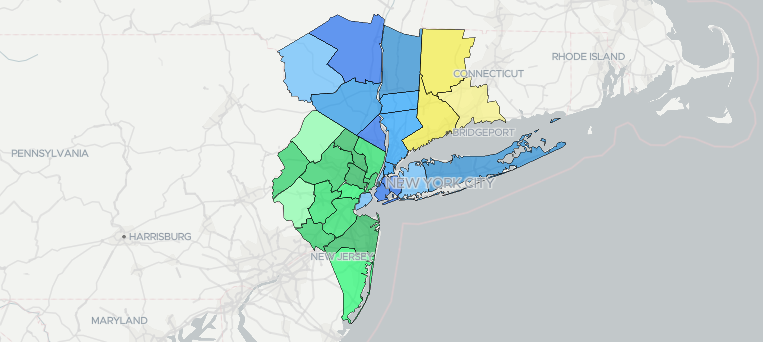
(image: Department of City Planning)
New York City is the world’s most popular city. We do lots of things exceptionally well here. But one thing we don’t do well is democracy. Voting rates within New York City are at historic lows, and corruption in Albany is at historic highs. Our politics is, in a word, an embarrassment.
But it’s not New Yorkers’ fault.
One of the oldest rules in politics is “divide and conquer,” and anyone who looks at a map of New York City and its metropolitan area, and compares it to a similarly scoped map of other big American cities, will see that we have been divided and conquered by our political boundaries. I’m not talking about gerrymandered districts, which are some of the most obscene in the nation, but something even more fundamental: the borders of our counties and our states.
The United States system of government is designed to operate with four layers: federal, state, county, and locality (city/town/village). This system works relatively well for most cities. Los Angeles, as a city, sits entirely within Los Angeles county, and it’s metropolitan area of 18 million people sits entirely within 4 counties, all of which are located in California. Chicago, as a city, like L.A., sits entirely within a single county: Cook County. It’s metro area of 10 million people inhabit 13 counties that extend into Indiana and Wisconsin, with the amount of “out of state” residents of “Chicagoland” numbering under a million in each state.
New York City simply doesn’t fit the U.S. model. Our city of over 8 million people is one of the only ones in the U.S. to extend beyond a single county: we have five. We call them boroughs here because…history. And each one has government appendages from a less integrated past: presidents, public administrators, courts, sheriffs, district attorneys, museums, and libraries. These institutions all cost taxpayer money to operate, and their opaque nature outside the normal purview of a city government makes them a great place for corruption to emerge. For example, longtime Brooklyn District Attorney Joe Hines was a master of using county level institutions to steal public money and punish opponents.
Zooming out to our metropolitan area (aka the “tri-state area,” “NYMetA,” etc.) and things get even more messy: a population of 23 million people spread over 25 counties and four states, with over 12 million living outside New York City and over 4 million living outside New York State. This creates lots of problems: people earning money in New York City and New York State can easily escape its taxes. It makes coordinating regional level solutions to housing and transit much more difficult. It means the municipalities and counties in our metro region can’t build the political clout needed to get things done at the state level because so many of us live in different states!
And what are the results? Our metro region’s tax dollars fund massive corruption. New York is, by some counts, the most corrupt state in the country. We also have the largest amount of debt per resident. New Jersey isn’t far behind when it comes to corruption or debt. Connecticut is, in the words of The Daily Beast, “collapsing.”
Many people blame badly drawn borders for the continued persistence of corrupt, authoritarian governments in the Middle East. (Tragically, misguided U.S. foreign policy hasn’t helped.) We can and should blame outdated political borders for our failing state and local politics here as well.
While that might seem depressing, it’s worth reminding that, over time, borders change, and so does their importance. New trade agreements, political institutions, forms of transit, financial systems, and political alliances have shifted the meaning of borders throughout history. We’re not stuck -- but we do need to think outside our borders and build institutions that reduce the cost and increase the effectiveness of regional collaboration. This type of activity is more important than ever because many policy-makers, business leaders, and futurists are predicting that, during the 21st century, networks of cities -- not nation-states -- will become the primary entities coordinating global political and economic activities. Some people are calling this new political philosophy “municipalism.”
If New Yorkers want to benefit from these new geopolitical trends, we need to build regional, democratic institutions that can represent the interests of all the residents of our metropolitan area.
Yes, we have the Regional Planning Association, the Port Authority, and dozens of other “regional” coordinating entities, but none of them have democratic representation of the public as their core mission: and that’s precisely what we need.
There are many questions to answer: who would New York Metropolitan Area (NYMetA) represent, and how does that representation work? Where and how could it derive economic, cultural, and political legitimacy? Where does it fit in a nation of towns, counties, and states? Could it become its own government layer with its own tax base? Or maybe it could live within civil society: as a political party, a social movement, or maybe a cooperatively run government public policy think tank?
While the idea of a legitimate NYMetA government might seem ridiculous and way off in the distance, the mere idea can be used to challenge the political status quo, which has fortified itself within the existing political borders and relies on our lack of political imagination to retain power.
Discussing and developing a plan for NYMetA enables us to imagine ways outside our antiquated political system that can’t seem to perform simple tasks like keeping the trains running, much less have them running on time.
If New York can’t do it, NYMetA can!
***
Devin Balkind is a technologist and nonprofit executive who works on civic technology projects in New York City. On Twitter @DevinBalkind.
***
Have an op-ed idea or submission for Gotham Gazette? Email This email address is being protected from spambots. You need JavaScript enabled to view it.
With Fake Clinics Proliferating, New Yorkers Should Know Their Reproductive Health Care Rights
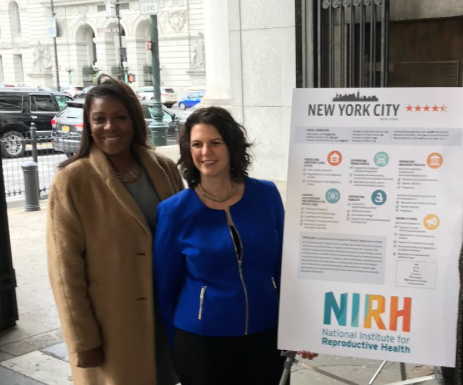
Letitia James and Andrea Miller, the authors
When visiting a health care provider, most patients trust that they’ll get a reasonably high standard of medical care and assume that their medical providers will keep their information confidential, and are not actively trying to deceive them. But around the country, 2,700 fake women’s health centers – which sometimes call themselves “crisis pregnancy centers” – are lying to women and giving false information in order to prevent women from having abortions. One hundred of them are here in New York State.
It is imperative that any New York woman or teen who is pregnant, or thinks she might be, can get accurate health care information and knows her rights, including the right to have an abortion.
That’s why the National Institute for Reproductive Health (NIRH) and New York City Public Advocate Letitia James have just released “Know Your Rights,” a public awareness and education brochure, so pregnant New Yorkers, those who might be pregnant, and their families and loved ones, can access accurate information about pregnancy and abortion, regardless of whether a woman chooses to continue her pregnancy or not.
Fake clinics actively trick and lure women into their centers. They set up shop near legitimate health care providers and brand themselves with words like “women’s choices” or “pregnancy resources” to suggest they provide all-options counseling and care to help women and teens make fully informed decisions; they advertise free pregnancy tests and ultrasounds. Inside, these clinics can look and feel like a real doctor’s office — staff wear white coats or medical scrubs, and pamphlets about pregnancy and ultrasound machines are located in exam rooms. The staff will often lie to women, either telling them that they are farther along in their pregnancy than they really are, and that it is too late for an abortion or that it is earlier in pregnancy than they really are, and they should wait before making any decisions.
Fake clinics are often part of national anti-abortion networks, and they target women from low-income communities, communities of color, and immigrant communities. Alarmingly, fake clinics outnumber real abortion providers by as much as four-to-one nationwide.
New York City saw the dangers these fake clinics posed and passed Local Law 17 in 2011, which took effect in 2016, requiring them to disclose that they don’t have a licensed medical provider on site and to keep client information confidential. Unfortunately, many fake clinics fail to comply with this law.
In light of the federal government’s continued attempts to undermine access to abortion and the current Supreme Court’s indifference to the harms posed by fake clinics, New York must work twice as hard to protect our residents’ right to accurate medical information and abortion care. We must retain our reputation as a state that protects and supports women and girls.
NIRH and Public Advocate James are committed to protecting the reproductive health and rights of all New York women. "Know Your Rights," available at the NIRH website, the public advocate website, and in hard copy around the city, provides a list of legitimate health care providers that offer prenatal care and abortion, and information regarding privacy rights.
New York City residents deserve nothing less.
***
Letitia James is New York City Public Advocate. Andrea Miller is President of the National Institute for Reproductive Health (NIRH). On Twitter @TishJames and @AMillerNIRH.
***
Have an op-ed idea or submission for Gotham Gazette? Email This email address is being protected from spambots. You need JavaScript enabled to view it.




